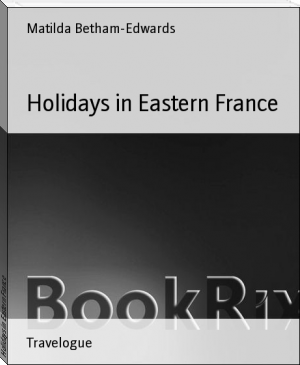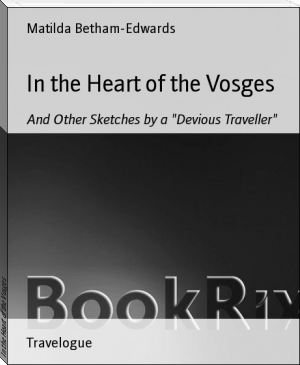Holidays in Eastern France, Matilda Betham-Edwards [best ebook reader under 100 txt] 📗

- Author: Matilda Betham-Edwards
Book online «Holidays in Eastern France, Matilda Betham-Edwards [best ebook reader under 100 txt] 📗». Author Matilda Betham-Edwards
Before quitting these mausoleums and their exquisite possessions of pleureuses, geniuses, Sibyls, and the rest, it may be worth while to remind the reader that, according to the most learned of the Romans, there were ten Sibyls, viz.:--1. Persica, 2. Libyssa, 3. Delphica, 4. Cumaea, 5. Erythraea, 6. Samia, 7. Cumana, who brought the book to Tarquin, 8. Hellespontica, 9. Phrygia, 10. Tiburs, by name Albunea, worshipped at Tiber as a goddess. Thus Varro categorizes the Sibyls, and besides these we hear of a Hebrew, a Chaldaean, a Babylonian, an Egyptian, a Sardian Sibyl, and some others. Other writers considerably reduce this number, three being that most usually accepted, and Salmasius, the most learned man that ever lived, summed up the various theories concerning these mysterious beings with the words: "There is nothing on which ancient writers more widely differ than as to the age, number, and country of the Sibyls."
There is little to see in the Church of Brou besides these mausoleums, and nothing in Bourg itself, except the fine bronze statue to Bichat, by David d'Angers. The great anatomist is represented in the act of oscultation, the patient being a child, standing between his knees. It is a monument alike worthy of the artist and his subject, another instance of that dignified realism for which David d'Angers was so remarkable. There is, however, some doubt as to Bichat's birth-place; Lons-le-Saunier, as I have before mentioned, contesting the honour with Bourg. On the principle that two monuments to a great man are better than none at all, each place claims the honour.
The night mail-express from Geneva whirled me in about ten hours to Paris, and the next morning I found myself in what, after the matchless atmosphere of the Jura, seemed murkiness, although the day was fine and the sky cloudless. I had thus, with hardly an important deviation from the plan originally laid down, accomplished my journey in Eastern France, but with a success, in one respect, impossible to anticipate. Accustomed as I am to French amiability and hospitality, I was yet unprepared for such a reception as that accorded to me throughout every stage of my travels. All hearts were open to me; everyone wanted to do the honours of his beloved "patrie"--using the word in its local rather than national sense--to be serviceable, kind, accommodating. Thus it happened that my holiday rambles in Franche-Comte were so far novel, that they may be said to have been accomplished without hotels or guidebooks; for the most part, my time being spent in friends' houses, and my itineraries being the best possible, namely, the oral information of interested natives of every place I passed through. This is, indeed, the way in which all countries, and especially France, should be seen, for, without a sympathetic knowledge of her people and their ways of life, we lose the most interesting feature in French travel. Travellers who only see the outside of things in foreign countries, indeed, may be compared to those who gaze upon a skeleton, instead of the living form, warm with life, sympathy, and beauty. Old France, as studied in her glorious monuments, whether Gallic, Merovingian, Mediaeval, or Renaissance, pales in interest before the New, that France which alone has taught the world the lesson of Equality, and is teaching us every day what misfortunes may be overcome by a noble people, inspired with true patriotism, allied to democratic feeling. In Republican France, now, who can doubt? and I am all the more thankful here to be able to bear witness to the unanimity, prosperity, and marvellous development found in the different strata of French social life. There are, without doubt, blots on this bright picture; but none can deny that the more we learn to know France the more we admire and love her, and that, if the richest and most beautiful country in the world, it is also the one in which happiness and well-being are most generally diffused. We are accustomed to regard France in the light of a parable to other nations, but, if her sorrows and retributions have taught them much, at least her successes and triumphs have taught them more. She has lately shown herself greater even in the hour of her prosperity than in that of evil fortune, the highest praise to be accorded alike to nations as to individuals. Honour then to all who have helped in bringing about these great results, whether in the humblest or loftiest walks of life, and may I be the means of inducing scores of travellers to follow in my footsteps, and judge for themselves whether I have drawn too glowing a picture! Of one thing they may be certain--namely, that they will be welcomed wherever they go, if led thither in a sympathetic spirit, although, perhaps, not many may have the like good fortune with myself, each stage of my journey being marked by delightful acquaintances and friendships, binding me still closer to La Belle France and her glorious Republic!
APPENDIX.
ITINERARIES.--OUTLINES OF FRANC-COMTOIS HISTORY. NOTES ON THE GEOLOGY OF THE JURA.
For the benefit of pedestrians, and these will most enjoy the country I have described, I adjoin some itineraries, more detailed than I was enabled to make my own. Hardy travellers will be well satisfied, in most instances, with the wayside inns they will find, and one advantage of travelling in Franche-Comte--at least, up to the present time--is its inexpensiveness. The chief outlay is in carriage hire, and those who can endure the diligence, or, better still, can accomplish most of their journeys on foot, where the railway is not available, will not only see the country to the best advantage, but at a very trifling cost. The excursions, or rather group of excursions, here mentioned, are such as may be accomplished in a few days from the town given as a starting point.
I. Besancon to Alaise and the valley of Nans. Departure by way of the route de Beure. The river Loue is crossed at Cleron. From Amancey ascend the plateau above Coulans, where a view is obtained of the oppidum of Alaise (supposed by some authorities to be the Alesia of Julius Caesar). Descend to the mill of Chiprey, follow the right bank of the Lison to Nans. At Nans, visit the Grotte Sarrazine, the source of the Lison, and the Pont du Diable. Ascend the fortress of St. Agne for the sake of the panorama; ancient dwellings of the Gauls to be seen at Chatillon, also tombs at Foure, see also the Cascade of the Gour de Couche, the Col de la Langutine, descend by way of the Taudeur to the plain of Myon, bounding the western side of the Alesia, i.e., the Alesia of some authorities.
II. Luxeuil (Luxovium) in Haute Saone. Celebrated from the ancient times for its ferruginous springs. Here visit the Roman remains, mediaeval houses, the town for the sake of the view. Make excursions into the valleys of the Vosges.
III. Vesoul and Gray, departure from Besancon by way of the charming valley of Ognon. See the Chateau de la Roche, turned into a school of agriculture, the sculptures in Vesoul church, its old streets, and pretty gardens. Visit the Port sur Saone (Portus Abucinus). At Gray visit the Hotel de Ville, the house of Simon d'Ancier, maitre-d'hotel of the Connetable de Bourbon. Visit the Abbey of Pesmes which contains some fine Renaissance work, the ancient Abbey of Acey, the Chateau de Balancon, Marnay, ancient domain of the Joinvilles, Ruffey--Roman city destroyed by the Vandals.
IV. From Besancon to Pontanier (Abiolica)--a beautiful bit of railway. The Doubs is crossed twice, when views are obtained of Arguel and Montferrand, and the modern chateaux of Torpes and Thoraise. The Loue is crossed at Mouchard; fine view of the ruins of Vaugrenant. After leaving Mouchard, the traveller enjoys a succession of vast prospects of the vineyard region of the Jura--Aiglepierre, Marnoz, Arbois, &c. After the vines, come the pinewoods and the splendid forest of Joux. After the pinewoods generally come the peat-fields, or tourbieres, of Chaux d'Arlier, traversed by two rivers which here meet, the Doubs and the Drugeon. Lastly, Pontarlier is reached, eight hundred and seventy yards above the level of the sea, anciently a confederation of nineteen villages, called la baroichage.
V. From Besancon to Dole. Four routes are here open to the traveller; 1st. The Roman road leading formerly from Vesontio to Cabillorum; 2nd. the route de Paris; 3rd. the railway--Dijon line; 4th. the canal, from the Rhone to the Rhine. All these ways of communication follow the valley of the Doubs. The great forges of Fraisans, and the Roman station of Crusinia, are to be seen on the way. To the right of this is a huge mass of granite in the midst of the Jurassic formation. Dole is the second city in Franche-Comte, and houses are to be seen there. The public library is also worth a visit.
VI. The fortress of Joux and the Swiss routes. Two fortresses protect the Swiss frontiers, Joux and Larmont. The former merits a visit. The cells are seen in which Toussaint l'Ouverture, Mirabeau, the poet Kleist, and other illustrious prisoners were confined. In the neighbourhood of Joux are high mountain peaks from which magnificent views are to be had. Many interesting excursions to be made in this neighbourhood.
VII. The Falls of the Doubs, Morteau, and Montbenoit. Start from Morteau, visit the Falls and Lakes, also the Cols de Roches. Proceed to Montbenoit by the river Doubs. See the splendid rock at Entreroches. The church of Montbenoit is one of the historic monuments of France; here are to be seen statuettes and sculptures in wood, the work of Florentine artists in the sixteenth century, employed by the Abbe Carondelet, friend of Raphael and Erasmus.
VIII. Baume-les-Dames. By rail and road from Besancon or Montbeliard, passing the picturesque valley of the Doubs, rich in charming landscape and historic associations. Ruins of the Chateaux of Montfaucon and Vaite, to be seen on the way. At Baume-les-Daines, visit the ancient Abbey Church, now turned into a public granary,





Comments (0)